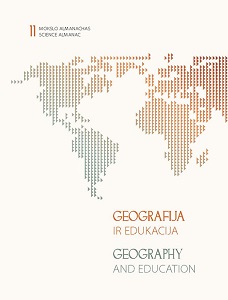BALTIJOS REGIONO ŠALTOJO LAIKOTARPIO ORO TEMPERATŪROS SĄSAJOS SU LEDO DANGOS IŠPLITIMU ARKTIES VANDENYNE
RELATIONSHIP BETWEEN COLD SEASON AIR TEMPERATURE IN THE BALTIC SEA REGION AND THE ARCTIC SEA ICE EXTENT
Author(s): Justina Kapilovaitė, Egidijus RimkusSubject(s): Regional Geography, Environmental Geography, Communication studies, ICT Information and Communications Technologies
Published by: Lietuvos geografų draugija
Keywords: teleconnections; Arctic Sea ice; AO; NAO; Baltic Sea region; air temperature;
Summary/Abstract: The variability of the atmospheric circulation described by the AO and NAO indices has a significant impact on the fluctuations of climate parameters in the Baltic Sea region. Many research show, that a decline in Arctic Sea ice extent increases the likelihood of negative phases of the Arctic Oscillation (AO) and North Atlantic Oscillation (NAO) in winter, and in the future could lead to more frequent relatively cold weather events during winter months in Baltic Sea region. This research is important for understanding possible teleconnections between Arctic Sea ice and atmospheric circulation (AO and NAO). In addition, this research helps to better understand the dynamics of Arctic Sea ice extent and Baltic Sea region air temperature, as well as AO and NAO circulation impact on the air temperature in the Baltic Sea region. A statistically significant decrease in the Arctic Sea ice extent and a statistically significant increase in the air temperature in the Baltic Sea region have been determined. The obtained results show that the expansion of the Arctic Sea ice in January-February with a delay of one month determines the AO and NAO values (correlation coefficients vary from 0.32 to 0.55). This means that if Arctic Sea ice decreases during winter months, AO and NAO indices are more likely to become negative as well. However, as the obtained correlations are not very strong, the results are insufficient to confirm the hypothesis that the Arctic Sea ice extent impacts negative AO and NAO phases likelihood and requires further research. A strong correlation between the Baltic Sea region air temperature and the values of AO/NAO indices has been established. The obtained results show that the Baltic Sea region air temperature variability in December-March is greatly influenced by the AO and NAO phases.
Journal: Geografija ir edukacija: mokslo almanachas
- Issue Year: 11/2023
- Issue No: -
- Page Range: 20-30
- Page Count: 11
- Language: Lithuanian

